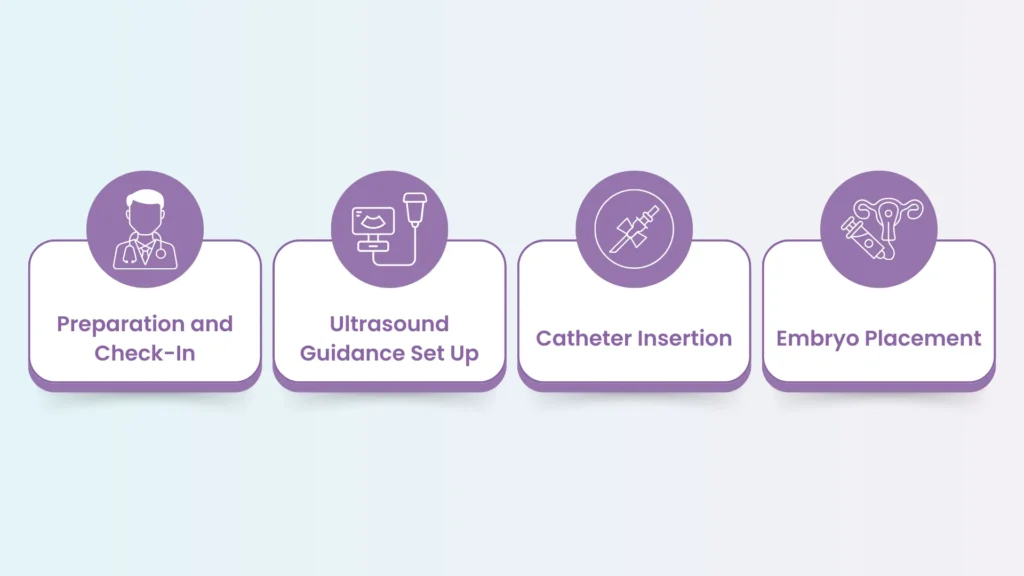Is the Procedure of Embryo Transfer Painful? What Surrogates Should Know

Many women wonder if the procedure of embryo transfer will be painful or uncomfortable. Surrogates can feel more at ease by understanding the process. This knowledge helps build confidence in their role in the surrogate process. Knowing what to expect, how to prepare, and when to seek advice can improve the experience.
Key Takeaways
- The procedure of embryo transfer is typically quick and minimally invasive, with only mild sensations like cramping or back pain experienced by most surrogates.
- Understanding what to expect during the procedure and recovery helps surrogates feel prepared and reduces concerns about discomfort or complications.
- Emotional support is essential throughout the surrogacy journey—connecting with your agency coordinator, practicing mindfulness, and leaning on your support network can help manage stress.
- Self-care and open communication with healthcare professionals help surrogates stay healthy, both physically and emotionally.
What Happens During the Procedure? Step-by-Step Overview

Becoming a surrogate is a big step and is very common for surrogates have many questions about the surrogacy process. The procedure of embryo transfer is an important part of the in vitro fertilization IVF and and plays a key role in achieving pregnancy. For surrogates, understanding each step helps reduce anxiety and ensures better preparation. Here’s what happens:
- Preparation and Check-In: Surrogates arrive at the clinic with a full bladder, which helps improve the accuracy of the ultrasound guidance setup. The medical team reviews the IVF cycles and confirms the number of embryos to be transferred. Light sedation may be offered to help surrogates feel relaxed.
- Ultrasound Guidance Setup: An abdominal ultrasound is used to monitor the transfer procedure in real time. Surrogates lie on a comfortable table. The doctor checks their positioning for the best view. This setup is to precisely placed into the uterine lining. This increases the embryo transfer success rates.
- Catheter Insertion: A soft catheter is gently inserted through the cervix into the uterus. Most surrogates report feeling only mild pressure, and the process is minimally invasive. The catheter holds the selected single embryo or multiple embryos, depending on the treatment plan.
- Embryo Placement: The doctor carefully places the embryos into the uterus, bypassing the fallopian tubes altogether, using the ultrasound for guidance. The nutrient-rich solution ensures the embryos are well-prepared for implantation. After the placement, the team removes the catheter. Then, surrogates rest for a short time. This helps support successful implantation.
Does Embryo Transfer Hurt? Separating Myth from Reality
The procedure of embryo transfer is often misunderstood. Many surrogates worry it might cause pain or discomfort. However, the process is generally quick, minimally invasive, and well-tolerated. Here’s what you need to know:
- Most surrogates experience little to no pain during the transfer procedure, it rarely causes significant discomfort.
- Common sensations include slight cramping or a feeling of fullness, which may result from the ultrasound guidance setup or having a full bladder. These sensations are temporary and typically resolve once the procedure is complete.
- After the procedure, mild symptoms such as back pain, or a stomach ache after embryo transfer are possible but not alarming. These symptoms are usually short-lived and can be managed with rest.
- For those undergoing a frozen embryo transfer, the experience is similar to a fresh transfer. The preparation ensures the process is smooth and reduces the likelihood of discomfort.
- Surrogates undergoing the surrogacy process should know that medical teams prioritize their comfort. They take steps to reduce pain and monitor closely for any unusual reactions.
What to Expect After the Procedure? Time and Recovery
The recovery period after the procedure of embryo transfer is generally quick. Most surrogates can resume their daily activities shortly after the process, but here’s what to expect during this time:
- A brief rest period follows the transfer, often about 30 minutes. This allows the body to relax and supports the initial steps of embryo implantation.
- Mild sensations, such as cramping after embryo transfer or a slight stomach ache, are normal. These typically fade within a few hours.
- Light spotting may occur, but it’s usually not a cause for concern. This can result from the catheter insertion or the early stages of implantation.
- Surrogates are often advised to avoid strenuous activities for the first 24 to 48 hours. This includes heavy lifting or intense exercise, as it helps the uterus remains calm.
- Emotional rest is just as important. Hormonal changes and the anticipation of the results can be overwhelming. Practicing relaxation techniques can help manage stress.
- A blood test and pregnancy test is scheduled about 10 to 14 days after the transfer to confirm whether implantation was successful. This period of waiting can be challenging, but it’s a necessary step in the surrogacy process.
Tips for Reducing Discomfort During the Procedure
The procedure of embryo transfer is generally quick and painless, but some steps can help surrogates minimize any potential discomfort. Here are practical tips to make this process of surrogacy as easy as possible:
- Stay hydrated: Drinking water before the procedure ensures a full bladder, which is necessary for better ultrasound guidance.
- Wear comfortable clothing: Loose, relaxed attire makes it easier to stay calm during the preparation and catheter insertion.
- Practice deep breathing: Controlled breathing helps relax the body and reduces tension that may cause mild sensations like cramping or pressure.
- Communicate with your doctor: Let the medical team know if you feel any discomfort during the transfer procedure. They can make adjustments to improve your comfort.
- Bring a support person: Having a trusted companion can ease anxiety and provide emotional reassurance throughout the process.
- Focus on relaxation: Visualization techniques or listening to soothing music can help distract from any mild sensations during the procedure.
- Follow pre-procedure instructions carefully: This includes adhering to any guidelines about medications or preparation for the embryo transfer success rates to remain optimal.
When to Speak to Your Doctor About Pain
After the procedure of embryo transfer, mild discomfort or sensations are common. However, it’s important for surrogates to know when to reach out to their doctor. Here are some signs that may require medical attention:
- Severe or prolonged pain: If you experience intense cramping or pelvic pain that lasts more than a few hours, it could indicate a complication, such as an ectopic pregnancy or another issue.
- Heavy bleeding: Light spotting is normal, but if you notice heavy bleeding or clotting, it’s important to consult your doctor. This could signal a problem with the uterine lining or embryo implantation.
- Back pain after embryo transfer: If it is sharp, persistent, or worsening may be a sign of a more serious concern. It’s always better to seek medical advice if it doesn’t improve with rest.
- Stomach ache: A pain that doesn’t subside or is accompanied by nausea, vomiting, or dizziness could point to an issue that needs immediate attention.
- Fever or chills: These symptoms may be a sign of infection, particularly if they occur within a few days after the procedure.
- Absence of pregnancy symptoms: If you notice no signs of pregnancy, like no mild cramping or breast tenderness (though this can vary), it’s worth mentioning during your follow-up.
Emotional Considerations: Staying Calm and Positive
The procedure of embryo transfer can be a stressful experience for many surrogates, not just physically but emotionally as well. Managing stress and emotions is important for both personal well-being and the success of the embryo implantation process. Here are some tips to stay calm and positive during this time:
- Acknowledge your feelings: It’s normal to feel nervous or anxious about the procedure. Accepting those emotions helps prevent them from becoming overwhelming.
- Practice mindfulness: Focusing on the present moment can help reduce stress and improve overall well-being. Simple techniques like deep breathing, meditation, or gentle yoga can promote relaxation.
- Connect with your agency coordinator: A good surrogacy agency offers more than administrative support. They also provide emotional support, which can bring much-needed relief. Reach out to your coordinator whenever you need guidance or reassurance.
- Set realistic expectations: Understand that the surrogacy process can be emotionally taxing, and it’s okay to feel a mix of hope, excitement, and uncertainty. Managing expectations helps keep anxiety in check.
- Stay connected with your support network: Having friends, family, or a partner to talk to can provide reassurance and help process any emotional concerns.
- Engage in self-care: Taking care of your body and mind during this time is important. Whether it’s reading a book, taking a walk, or enjoying a favorite hobby, these activities can help reduce stress and elevate mood.
- Focus on the bigger picture: Remember why you’re on this journey: to help build a family. Keeping the end goal in mind can provide comfort during challenging moments.
- Ask for professional support. If you find the emotional strain overwhelming, it might help to speak with a counselor or therapist familiar with the surrogacy process. They can offer coping strategies and guidance.
Understanding the procedure of embryo transfer is important for surrogates as they go through this key step in the surrogacy process. It’s normal to feel some mild discomfort, like cramping or back pain after embryo transfer, but these usually go away quickly and aren’t a sign of anything serious. By staying informed and using relaxation techniques, surrogates can reduce their worries and approach the procedure with confidence.



